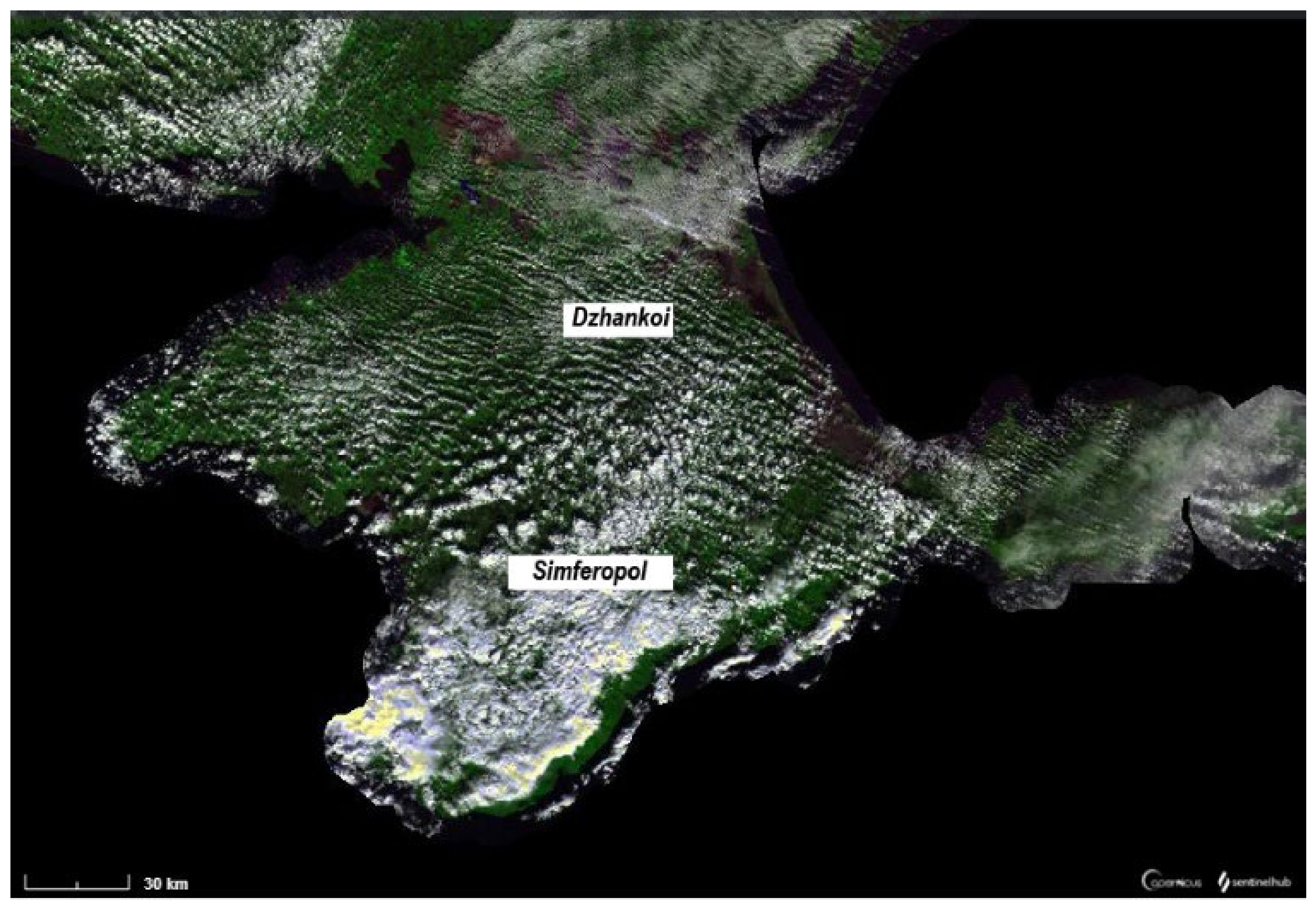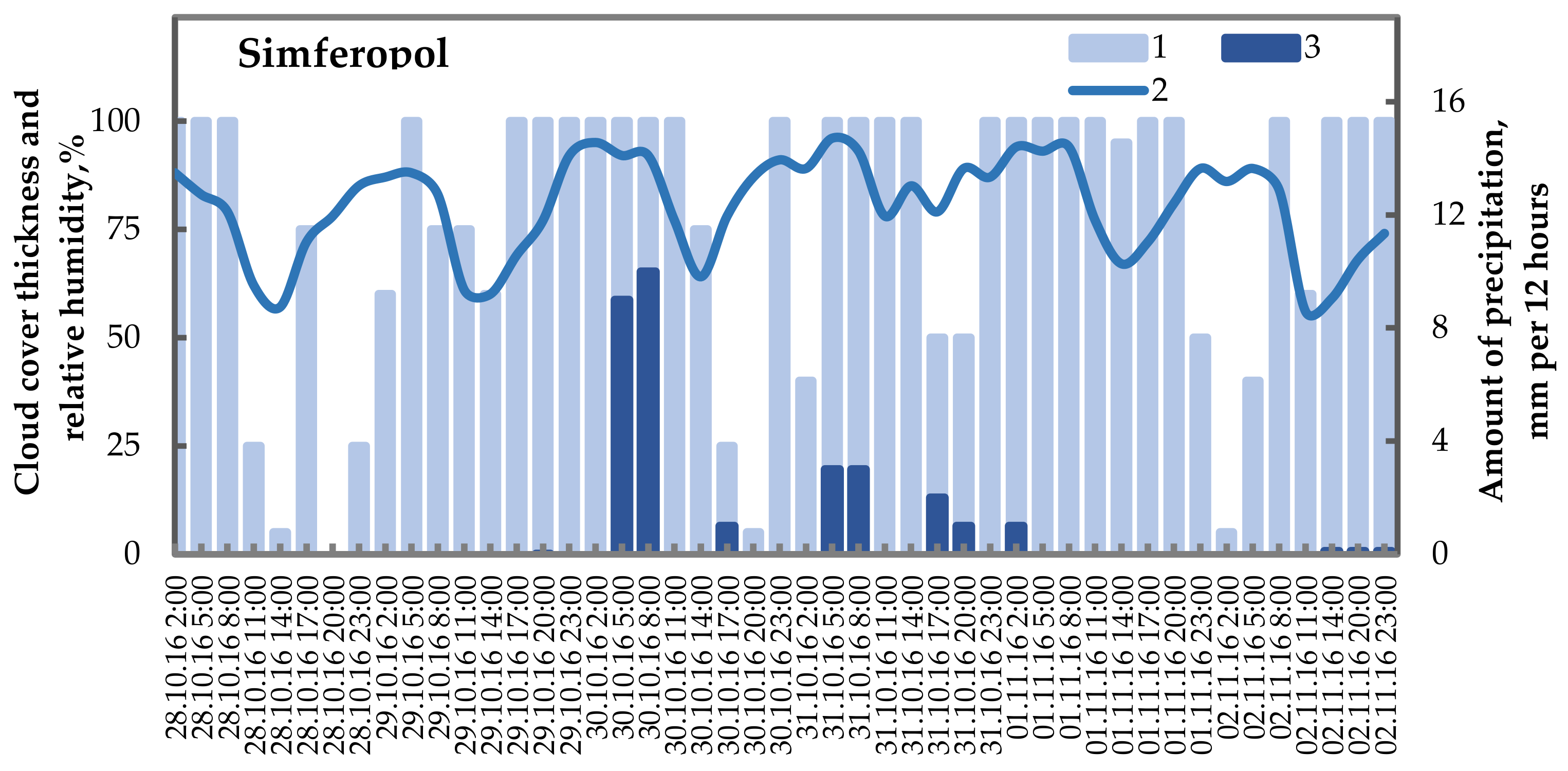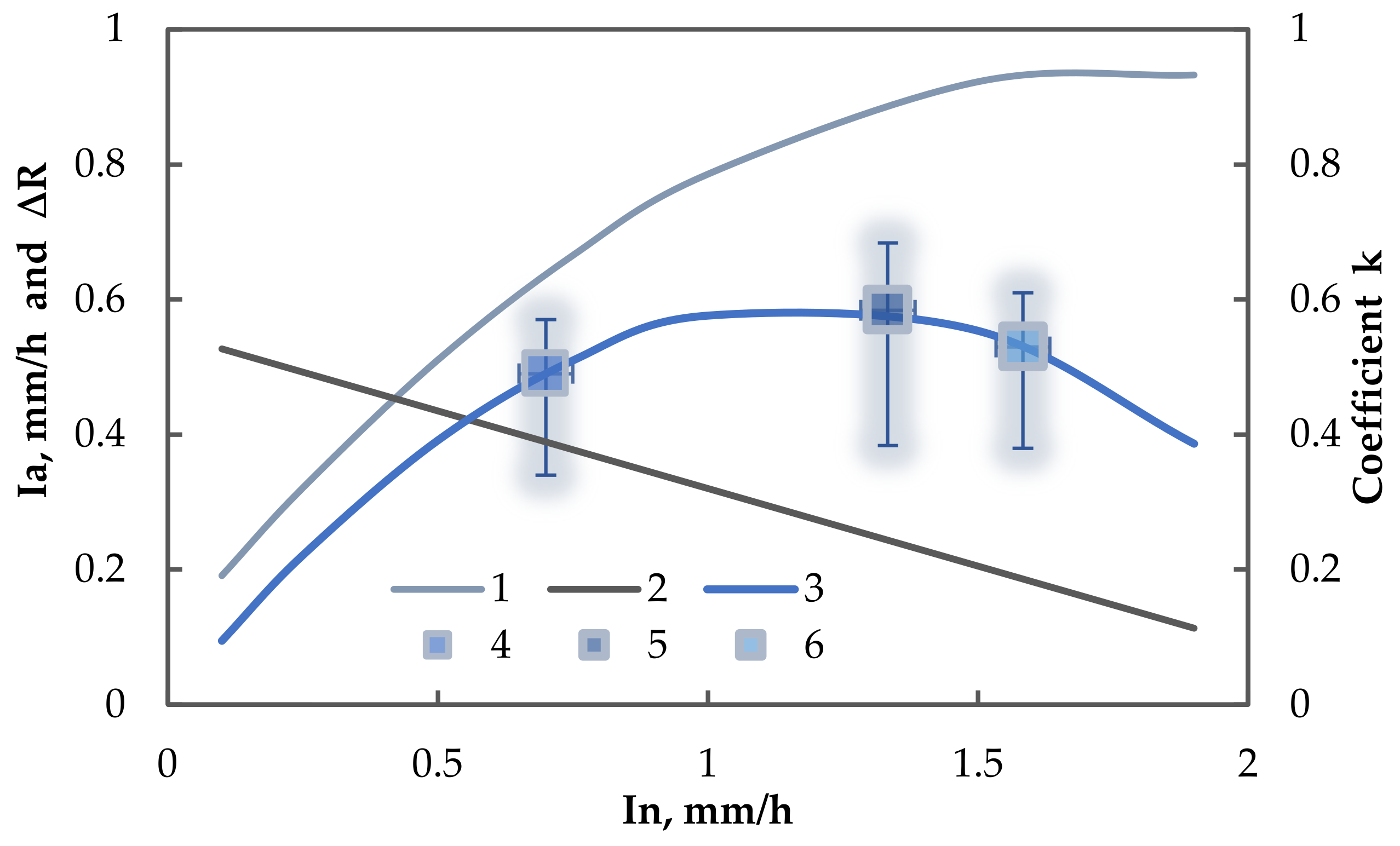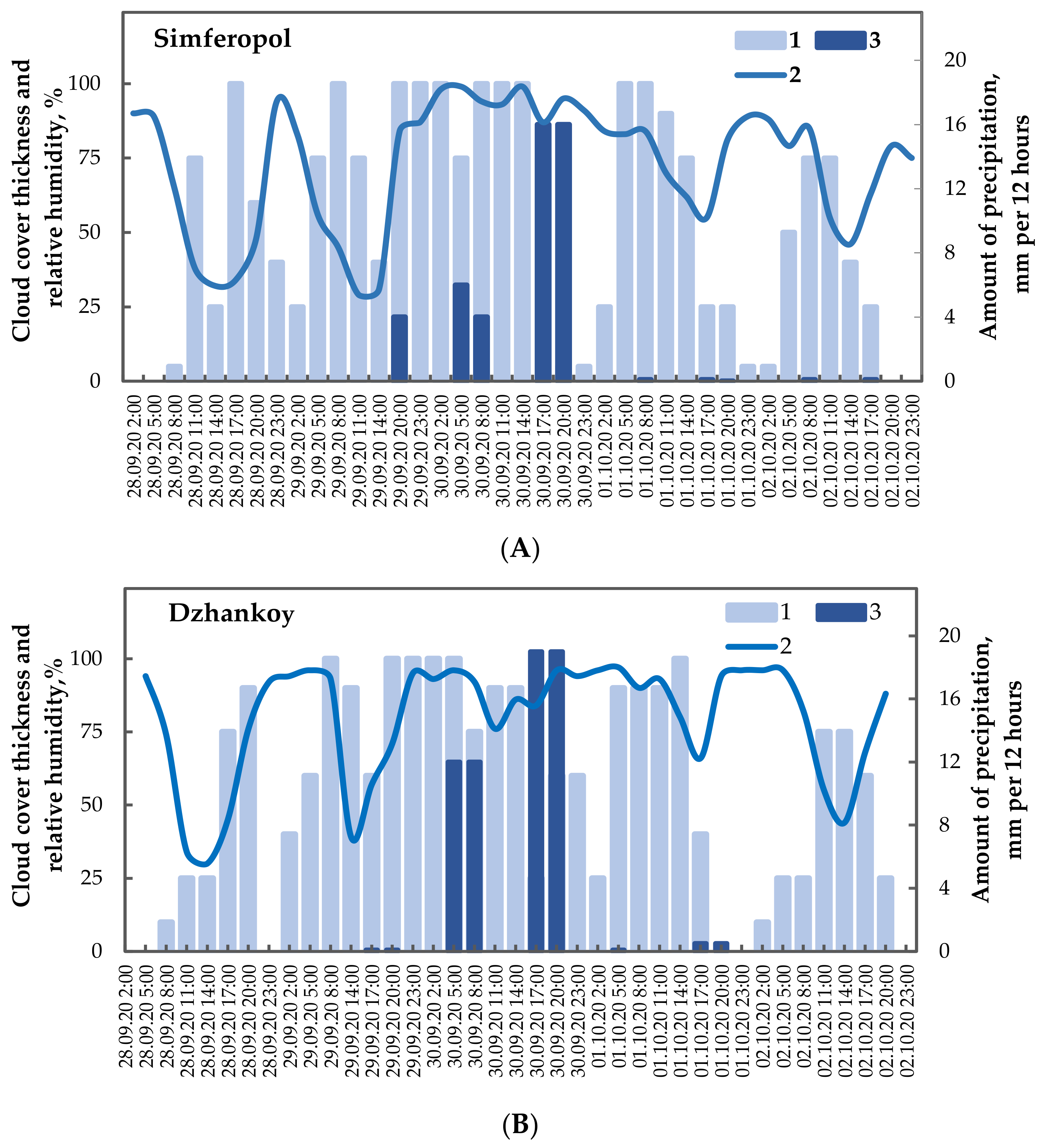Changes in the Water Surface Area of Reservoirs of the Crimean Peninsula and Artificial Increases in Precipitation as One of the Possible Solutions to Water Shortages
Abstract
:1. Introduction
- Usage of groundwater resources from wells. Groundwater is the main source of domestic potable water in semi-arid regions [2,12,13]. Thus, the proportion of groundwater in a general, balanced water supply exceeds 70% in various countries of Europe, including Ukraine. At the global level, this varies from one country to the next; groundwater exploitation covers approximately 50% of drinking water needs, 20% of the demand for irrigation water, and 40% of the needs of self-supplied industry [14]. The groundwater of the Crimean Peninsula, which comes mainly from karst aquifers, provides about 40% of the water budget and services about 50% of the Crimean population (1.0–1.5 million people). The demand for water resources increases in summer due to the influx of tourists (up to 6 million people), but the average annual demand increased dramatically after 2014. In 2018 alone, about 0.12 km3 of water was extracted from 1204 artesian wells, while the maximum sustainable withdrawal rate is 0.04 km3 [14]. For example, wells have been drilled near Simferopol that can provide up to 10,000 m3 of water per day, but the water is often brackish and requires further treatment [14,15]. However, an increase in the consumption of groundwater resources may lead to a decrease in the hydraulic pressure of the aquifer, and to their depletion in the near future.
- Usage of submarine groundwater discharges into the sea. Fresh submarine groundwater discharge is widely valued as a water resource for drinking, hygiene, agriculture, fishing, tourism, culture, or ship navigation [16]. For instance, in Peru, this source of water is used for drinking, while it is used for bathing in Tahiti, and for irrigation in Greece [17]. A first dam, separating fresh and salty sea water, was built in karst galleries near Marseilles, following which fresh water enters the urban water supply system [18]. Similar work has been carried out in the coastal zones of the Mediterranean, as well as in other regions [19]. According to preliminary estimates, there are reserves of fresh submarine groundwater discharge under the Sea of Azov of about 0.5–1.2 billion m3, but this water can only conditionally be used for drinking [20,21]. This is low-mineralized water, which can be used only for technical purposes: irrigation, heating, and cooling systems. This water can be used as drinking water only after filter treatment and disinfection [21].
- Large-scale collection of precipitation in the Crimean Mountains, using karst cavities as underground water reservoirs (underground water collectors) [22,23,24]. The maximum water accumulation occurs in spring (February–March), and by summer the water levels begin to decrease in the caves [25]. For example, the accumulated water of the caves at the Karasu-Bashi gorge is discharged through narrow karst tunnels. The water channels are laid at the cave exits to supply fresh water to Bilogorsk.
- Desalination of brackish groundwater and seawater. Selection of the appropriate technology for the desalination of brackish groundwater and seawater should be performed based on water, energy consumption, and brine disposal, as well as environmental risks and cost considerations [26,27]. In particular, there are problems with the disposal of concentrated brine. When brine is discharged back into the sea, it may lead to an increase in water salinity and a reduction of the desalination plant efficiency. Dumping this concentrate can cause it to seep into the groundwater. Membrane-based desalination technologies are used in treating brackish groundwater in Crimea. For example, the desalination plant was built on the seashore in Mykolaivka village and is expected to produce 40,000 m3 of water per day (resource: [28]).
- Reduction in water losses due to evaporation in reservoirs. In semi-arid regions, water losses increase due to evaporation from the surface of reservoirs, especially in summer. Partial coverage of reservoirs with the floating elements is applied to suppress evaporation losses [29]. For example, to solve the problem of evaporation in the United States, special black plastic balls are used, which cover the surface of reservoirs in California [30]. This has helped to reduce evaporation by 85%. In southeastern Spain, fabric materials are used to reduce reservoir evaporation by 70–80% in water-scarce conditions [31]. Additionally, an indirect effect of such protection against evaporation is a decrease in the concentration of salts in the water. This reduces soil degradation during irrigation [29,30].
Study Region
2. Materials and Methods
3. Results
3.1. Climate Change on the Crimean Peninsula
3.2. Climate Aridity Analysis Using the Drought Severity Index of the Crimean Peninsula
3.3. Changes in the Water Surface Area of Reservoirs in Crimea According to Radar Satellite Data Obtained from Sentinel-1 for the Period 2015–2021
3.4. Change in the Water Surface Area of the Simferopol Reservoir for the Period 2015–2021
3.5. Artificially Increasing Atmospheric Precipitation: Analysis of the Crimean Experience. One of the Possible Solutions?
- Active influences on atmospheric processes in October 2016
- 2.
- Active influences on atmospheric processes in September 2020.
4. Discussion
Use of Satellite Images for Analysis of the Environmental Situation at the Localized Level
5. Conclusions
Author Contributions
Funding
Institutional Review Board Statement
Informed Consent Statement
Data Availability Statement
Conflicts of Interest
References
- The United Nations World Water Development Report 2022: Groundwater: Making the Invisible Visible; Executive Summary. 2022. Available online: https://unesdoc.unesco.org/ark:/48223/pf0000380726 (accessed on 6 June 2022).
- Bates, B.C.; Kundzewicz, Z.W.; Wu, S.; Palutikof, J.P. (Eds.) Climate Change and Water; Technical Paper of the Intergovernmental Panel on Climate Change; IPCC Secretariat: Geneva, Switzerland, 2008; p. 210. Available online: https://archive.ipcc.ch/pdf/technical–papers/climate–change–water–en.pdf (accessed on 6 June 2022).
- Shinkarenko, S.; Solodovnikov, D.; Bartalev, S.; Vasilchenko, A.; Vypritskii, A. Dynamics of the reservoir’s areas of the Crimean Peninsula. Mod. Probl. Remote Sens. Earth Space 2021, 18, 226–241. Available online: http://d33.infospace.ru/jr_d33/2021v18n5/226-241.pdf (accessed on 6 June 2022).
- Karamushka, V.; Boychenko, S.; Kuchma, T.; Zabarna, O. Trends in the Environmental Conditions, Climate Change and Human Health in the Southern Region of Ukraine. Sustainability 2022, 14, 5664. [Google Scholar] [CrossRef]
- Bordi, I.; Fraedrich, K.; Sutera, A. Observed drought and wetness trends in Europe: An update. Hydrol. Earth Syst. Sci. 2009, 13, 1519–1530. [Google Scholar] [CrossRef]
- World Weather. 2022. Available online: https://en.tutiempo.ne/climate/ukraine.html (accessed on 6 June 2022).
- Efimov, V.; Volodin, E.; Anisimov, A.; Barabanov, V. Regional projections of climate change for the Black Sea–Caspian Sea area in late 21st century. Phys. Oceanogr. 2015, 5, 49–66. [Google Scholar] [CrossRef]
- Aleshina, M.; Toropova, P.; Semenov, V. Temperature and Humidity Regime Changes on the Black Sea Coast in 1982–2014. Russ. Meteorol. Hydrol. 2018, 43, 235. [Google Scholar] [CrossRef]
- Croitoru, A.-E.; Chiotoroiu, B.-C.; Ivanova Todorova, V.; Torică, V. Changes in precipitation extremes on the Black Sea Western Coast. Glob. Planet. Change 2013, 102, 10–19. [Google Scholar] [CrossRef]
- Keggenhoff, I.; Elizbarashvili, M.; Amiri–Farahani, A.; King, L. Trends in daily temperature and precipitation extremes over Georgia, 1971–2010. Weather Clim. Extrem. 2014, 4, 75–85. [Google Scholar] [CrossRef]
- Hou, J.; van Dijk, A.; Beck, H.; Renzullo, L.; Wada, Y. Remotely sensed reservoir water storage dynamics (1984–2015) and the influence of climate variability and management at global scale. Hydrol. Earth Syst. Sci. 2022, 26, 3785–3803. [Google Scholar] [CrossRef]
- Lisovsky, A.A.; Novik, V.A.; Timchenko, Z.V.; Gubskaya, U.A. Surface Water Bodies of Crimea. Management and Use of Water Resources: Reference Book; KRP Uchpedgiz: Simferopol, Crimea, 2011; p. 242. [Google Scholar]
- Groundwater Resources of the World and Their Use. 2004. Available online: https://unesdoc.unesco.org/ark:/48223/pf0000134433 (accessed on 6 June 2022).
- Miran’kov, D.B. Problems of overcoming water resource deficit in the Republic of Crimea: Adaptation of foreign experience. Scholarly Notes Crimean Federal University. Econ. Manag. 2018, 4, 93–107. Available online: https://cyberleninka.ru/article/n/problemy-preodoleniya-defitsita-vodnyh-resursov-v-respublike-krym-adaptatsiya-zarubezhnogo-opyta/viewer (accessed on 6 June 2022).
- Dublyansky, Y.V.; Klimchouk, A.B.; Tokarev, S.V.; Amelichev, G.N.; Spötl, C. Groundwater of the Crimean Peninsula: A first systematic study using stable isotopes. Isot. Environ. Health Stud. 2019, 55, 419–437. [Google Scholar] [CrossRef]
- Moore, W.S. The effect of submarine groundwater discharge on the ocean. Annu. Rev. Mar. Sci. 2010, 2, 59–88. [Google Scholar] [CrossRef] [PubMed]
- Moosdorf, N.; Oehler, T. Societal use of fresh submarine groundwater discharge: An overlooked water resource. Earth Sci. Rev. 2017, 171, 338–348. [Google Scholar] [CrossRef]
- Borisenko, L.S. Hydrogeological Conditions of Submarine Groundwater Discharge in the Crimea. Water Resour. 2001, 28, 15–21. [Google Scholar] [CrossRef]
- Rodellas, V.; Garcia–Orellana, J.; Masqué, P.; Feldman, M.; Weinstein, Y. Submarine groundwater discharge as a major source of nutrients to the Mediterranean Sea. Proc. Natl. Acad. Sci. USA 2015, 112, 3926–3930. [Google Scholar] [CrossRef]
- Ivanov, V.A.; Prusov, A.V.; Chepyzhenko, A.I. A Submarine Groundwater Discharge in the Region of the Cape Aya (Crimea). Rep. Natl. Acad. Sci. Ukr. 2010, 2, 103–109. Available online: https://www.libr.dp.ua/text/dan_2010_2_18.pdf (accessed on 6 June 2022).
- Resource: Fresh Water under the Sea of Azov. 2021. Available online: https://www.eurasiareview.com/12052021-russia-to-drill-for-fresh-water-under-azov-sea-not-to-help-crimea-but-to-back-its-claims-analysis/ (accessed on 6 June 2022).
- Fiorillo, F.; Ristić Vakanjac, V.; Jemcov, I.; Milanović, S.; Stevanović, Z. Karst Groundwater Availability and Sustainable Development. In Karst Aquifers—Characterization and Engineering. Professional Practice in Earth Sciences; Stevanović, Z., Ed.; Springer: Cham, Switzerland, 2015; pp. 421–530. [Google Scholar] [CrossRef]
- Klimchouk, A.; Tokarev, S. The problems of groundwater source protection for drinking water supply under conditions of exposed karst. Ukr. Geogr. Z. 2014, 1, 43–52. [Google Scholar] [CrossRef]
- Shestopalov, V.M.; Boguslavsky, A.S.; Klimchuk, A.B.; Fesenko, A.V.; Godenko, G.E. Modeling Groundwater Resources of the south–west Mountainous Crimea. Geol. Miner. World Ocean 2008, 4, 106–107. Available online: http://dspace.nbuv.gov.ua/handle/123456789/5318 (accessed on 6 June 2022).
- Fiorillo, F. Spring hydrographs as indicators of droughts in a karst environment. J. Hydrol. 2009, 373, 290–301. [Google Scholar] [CrossRef]
- Yvana, A.; Lienhard, J. Desalination of Brackish Groundwater to Improve Water Quality and Water Supply. In Global Groundwater: Source, Scarcity, Sustainability, Security and Solutions; Mukherjee, A., Scanlon, B., Aureli, A., Langan, S., Guo, H., McKenzie, A., Eds.; Elsevier: Amsterdam, The Netherlands, 2021; pp. 559–575. [Google Scholar] [CrossRef]
- Schroedera, D.; Guob, W.; Missimera, T. Groundwater quality change impacts on a brackish–water reverse osmosis water treatment plant design: The City of Clearwater, Florida. Desalination Water Treat. 2021, 211, 31–44. [Google Scholar] [CrossRef]
- Resource: Water Desalination in Crimea. Available online: https://www.dw.com/ru/opresnenie–vody–v–krymu–kak–dorogo–ono–obojdetsja–rossii/a–56399577 (accessed on 6 June 2022).
- Assouline, S.; Narkis, K.; Or, D. Evaporation suppression from water reservoirs: Efficiency considerations of partial covers. Water Resour. Res. 2011, 47, W07506. [Google Scholar] [CrossRef]
- Haghighi, E.; Madani, K.; Hoekstra, A.Y. The water footprint of water conservation using shade balls in California. Nat. Sustain. 2018, 1, 358–360. [Google Scholar] [CrossRef]
- Martinez–Alvares, V. Experimental Assessment of Shade–Cloth Covers on Agricultural Reservoirs for Irrigation in South–Eastern Spain. Span. J. Agric. Res. 2010, 8 (Suppl. S2), S122–S133. Available online: https://pdfs.semanticscholar.org/1238/c4cf4dd428fc07de955105a6cff4b3ad46dc.pdf (accessed on 6 June 2022). [CrossRef]
- Sylaev, A. (Ed.) Problems of Cloud Physics and Weather Modification; Naukova Dumka: Kyiv, Ukraine, 2004; p. 350. [Google Scholar]
- Essays on the History of Weather Modification in the USSR and The Post–Soviet Territory; Sb. RSHMU: Ufa, Russia, 2017; p. 352. Available online: https://www.researchgate.net/publication/324520952 (accessed on 6 June 2022).
- Charry, H.; Lininder, R.L. The AWS Handbook of Ground–Based Cold Fog Dissipation Using Vented Liquid Propane; Report AWS–TR–75–255; AIR Weather Service, United States AIR Force: Illinois, IL, USA, 1975; Volume 1—Theory and Practice, p. 55. [Google Scholar]
- Fan, J.; Leung, L.R.; Li, Z.; Morrison, H.; Chen, H.; Zhou, Y.; Qian, Y.; Wang, Y. Aerosol impacts on clouds and precipitation in eastern China: Results from bin and bulk microphysics. J. Geophys. Res. Atmos. 2012, 117, D00K36. [Google Scholar] [CrossRef]
- Fan, J.; Leung, L.R.; Rosenfeld, D.; DeMott, P.J. Effects of cloud condensation nuclei and ice nucleating particles on precipitation processes and supercooled liquid inmixed–phase orographic clouds. Atmos. Chem. Phys. 2017, 17, 1017–1035. [Google Scholar] [CrossRef]
- Hobbs, P.V.; Locatelli, J.D. Ice Nuclei from a Natural Forest Fire. J. Appl. Meteor. 1969, 8, 833–834. [Google Scholar] [CrossRef]
- Voloshchuk, V.M. The Kinetic Theory of Coagulation; Hydrometeoizdat: Leningrad, Russia, 1984; p. 283. [Google Scholar]
- Leskov, B.N.; Nerobeeva, T.D. On the suitability for the effects of frontal clouds that give precipitation. Sci. Work. UkrNDGMI 1971, 103, 34–41. [Google Scholar]
- Nosar, S.V.; Stepura, E.A. Assessment of Potential Artificial Increasing of Precipitation by Weather Modification in the Northern Black Sea Region during Cold Part of the Year (on Example, Kherson Region). Sci. Work. UkrNDGMI 2016, 269, 27–40. Available online: http://nbuv.gov.ua/UJRN/Npundgi_2016_269_6 (accessed on 6 June 2022).
- Nosar, S.V.; Stepura, E.A. Possibility of Artificial Increase in Winter Precipitation in the North–Western Black Sea Region (on Example, Mykolaiv Region). Sci. Work. UkrNDGMI. 2014, 266, 26–38. Available online: http://nbuv.gov.ua/UJRN/Npundgi_2014_266_6 (accessed on 6 June 2022).
- Gao, H.; Birkett, C.; Lettenmaier, D. Global monitoring of large reservoir storage from satellite remote sensing. Water Resour. Res. 2012, 48, W09504. [Google Scholar] [CrossRef]
- Terekhov, A.; Makarenko, N.; Pak, A.; Abayev, N. Using the digital elevation model (DEM) and coastlines for satellite monitoring of small reservoir filling. Cogent Eng. 2020, 7, 1853305. [Google Scholar] [CrossRef]
- Marynych, O. (Ed.) Geographical Encyclopedia of Ukraine; Ukrainian Soviet Encyclopedia: Kyiv, Ukraine, 1989; Volume 1, p. 416. (In Ukrainian) [Google Scholar]
- Lipinskyy, V.; Dyachuk, V.; Babichenko, V. (Eds.) The Climate of Ukraine; Rayevskyy Publishing: Kyiv, Ukraine, 2003; p. 344. (In Ukrainian) [Google Scholar]
- Google Earth Engine. 2022. Available online: https://code.earthengine.google.com/?accept_repo=users/tanyakuchma/Water_serface_change (accessed on 6 June 2022).
- EO Browser. 2022. Available online: https://apps.sentinel–hub.com/eo–browser (accessed on 6 June 2022).
- Schumann, G.J.P.; Moller, D.K. Microwave remote sensing of flood inundation. Phys. Chem. Earth 2015, 83, 84–95. [Google Scholar] [CrossRef]
- Recommended Practice: Agriculture Drought Monitoring and Hazard Assessment Using Google Earth Engine. 2022. Available online: https://un-spider.org/advisory-support/recommended-practices/recommended-practice-agriculture-drought-monitoring/in-detail (accessed on 7 July 2022).
- UN–Spider. 2021. Available online: https://www.un–spider.org/advisory–support/recommended–practices/recommended–practice–google–earth–engine–flood–mapping (accessed on 6 June 2022).
- Otsu, N. A Threshold Selection Method from Gray–Level Histograms. IEEE Trans. Syst. Man Cybern. 1979, 9, 62–66. [Google Scholar] [CrossRef]
- Geographic Information Systems Stack Exchange. 2022. Available online: https://gis.stackexchange.com/questions/364231/gee–smoothing–curve–of–detected–water–area/364305 (accessed on 6 June 2022).
- Antonov, S.V.; Bychkov, A.A.; Korneev, V.P.; Sergeev, B.; Chastuchin, A.; Shchukin, G. The use of unmanned aerial vehicles for support of works on weather modification of clouds and fog. Sci. Notes RGHMU 2019, 56, 9–18. [Google Scholar] [CrossRef]
- Koloskov, B.P.; Chastukhin, A.V.; Bychkov, A.A.; Petrunin, A.M.; Korneev, V.P.; Vasilenko, S.V.; Ilyin, V.M. Application of Ground–Based Aerosol Liquid Generators in Works on Artificial Precipitation Increase and Anti–Hail Protection. Reports of the Russian Conference on the Physics of Clouds and Active Influences on Hydrometeorological Processes: A Collection of Scientific Papers. Part 1; AETERNA: Ufa, Russia, 2017; pp. 66–73. [Google Scholar]
- Resource: Lords of the Rains. 2020. Available online: https://ru.krymr.com/a/poveliteli–dozhdey–v–krymu–vzyalis–za–iskusstvennie–osadki/30780239.html (accessed on 6 June 2022).
- Weather for 243 Countries of the World. 2021. Available online: http://rp5.ua (accessed on 6 June 2022).
- The Climate Cadastre of Ukraine (Standard Norms for the Period 1961–1990); Central Geophysical Observatory: Kyiv, Ukraine, 2005; p. 48. Available online: http://cgo-sreznevskyi.kyiv.ua/index.php?dv=pos-klim-kadastr (accessed on 6 June 2022).
- Open Data—Server. 2022. Available online: https://opendata.dwd.de/climate_environment/ (accessed on 6 June 2022).
- CGO: Central Geophysical Observatory of Empirical Data. 2021. Available online: http://cgo–sreznevskyi.kyiv.ua/index.php?lang=en&fn=u_klimat&f=ukraine&p=1 (accessed on 6 June 2022).
- Weather and Climate. 2022. Available online: http://pogodaiklimat.ru/archive.php (accessed on 6 June 2022).
- Von Storch, H.; Zwiers, F.W. Statistical Analysis in Climate Research; Cambridge University Press: Cambridge, UK, 1999; p. 495. [Google Scholar]
- IPCC. 2021: Summary for Policymakers. In Climate Change 2021: The Physical Science Basis. Contribution of Working Group I to the Sixth Assessment Report of the Intergovernmental Panel on Climate Change; Masson-Delmotte, V., Zhai, P., Pirani, A., Connors, S.L., Péan, C., Berger, S., Caud, N., Chen, Y., Goldfarb, L., Gomis, M.I., et al., Eds.; Cambridge University Press: Cambridge, UK; New York, NY, USA, 2021; pp. 3–32. Available online: https://www.ipcc.ch/report/ar6/wg1/ (accessed on 6 June 2022).
- Boychenko, S.; Voloshchuk, V.; Movchan, Y.; Serdjuchenko, N.; Tkachenko, V.; Tyshchenko, O.; Savchenko, S. Features of climate change on Ukraine: Scenarios, consequences for nature and agroecosystems. Proc. Natl. Aviat. Univ. 2016, 4, 96–113. [Google Scholar] [CrossRef]
- Boychenko, S.; Voloshchuk, V.; Kuchma, T.; Serdyuchenko, N. Long-time changes of the thermal continentality index, the amplitudes and the phase of the seasonal temperature variation in Ukraine. Geofiz. Zhurnal 2018, 40, 81–96. [Google Scholar] [CrossRef]
- Popovych, V.F.; Dunaieva, I.A. Standardized Precipitation Index Usage for Reservoirs Operation Regime Analysis. Water Ecol. Probl. Solut. 2018, 3, 39–47. [Google Scholar] [CrossRef]
- Resource: Crimea Started Transferring Water from the Taigan to the Simferopol Reservoir. 2020. Available online: https://ru.krymr.com/a/news–v–krymu–nachali–perebrasyvat–vodu–iz–tajganskogo–vodohranilishcha/30767053.html (accessed on 6 June 2022).
- Resource: Streets Are Flooded, Cars Are Floating. 2020. Available online: https://krym.aif.ru/incidents/details/zatopleny_ulicy_plyvut_avto_na_stradayushchiy_ot_zasuhi_krym_obrushilsya_liven (accessed on 6 June 2022).
- Boychenko, S.; Kuchma, T. About the Efficiency of Active Influences on the Atmospheric Processes Aiming at the Artificial Increase of Precipitation over the Crimean Peninsula in September 2020. In Proceedings of the 3rd International Conference: “Recent Trends in the Development of Information Systems and Telecommunications Technologies”, Kyiv, Ukraine, 25–26 January 2021; pp. 13–16. Available online: https://zenodo.org/record/4540480#.YZTDSWDP02w (accessed on 6 June 2022).
- Donchyts, G.; Baart, F.; Winsemius, H.; Gorelick, N.; Kwadijk, J.; van de Giesen, N. Earth’s surface water change over the past 30 years. Nat. Clim. Change 2016, 6, 810–813. [Google Scholar] [CrossRef]
- Vanthof, V.; Kelly, R. Water storage estimation in ungauged small reservoirs with the TanDEM–X DEM and multi–source satellite observations. Remote Sens. Environ. 2019, 235, 111437. [Google Scholar] [CrossRef]
- Avisse, N.; Tilmant, A.; Müller, M.; Zhang, H. Monitoring small reservoirs storage from satellite remote sensing in inaccessible areas. Hydrol. Earth Syst. Sci. Discuss. 2017, 21, 6445–6459. [Google Scholar] [CrossRef]












| Stations | Region | Code | Latitude, Degrees | Longitude, Degrees | Altitude, m | Period | Source |
|---|---|---|---|---|---|---|---|
| Ai–Petri | CM1 | 33998 | 44.43 | 34.08 | 1180 | 1991–2021 | [58] |
| Alushta | SCC | 33959 | 44.67 | 34.43 | 7 | 1991–2021 | [59,60] |
| Dzhankoy | CS2 | 33934 | 45.72 | 34.40 | 8 | 1991–2021 | [59,60] |
| Kerch | CS1 | 33983 | 45.37 | 36.43 | 49 | 1900–2021 | [59,60] |
| Yevpatoria | CS1 | 33929 | 45.18 | 33.37 | 10 | 1902–2021 *, 1936–2021 ** | [59,60] |
| Simferopol | CM2 | 33946 | 44.68 | 34.13 | 181 | 1900–2021 | [58,60] |
| Feodosia | SCC | 33976 | 45.03 | 35.38 | 26 | 1900–2021 | [59,60] |
| Yalta | SCC | 33990 | 44.48 | 34.17 | 72 | 1900–2021 | [59,60] |
| Stations | Temperature, °C | Precipitation, mm/Year | ||||
|---|---|---|---|---|---|---|
| 1961–1990 | 1991–2020 | 1961–1990 | 1991–2020 | |||
| <T> ±σ, °C/Year | <T> ±σ, °C/Years | Ttrn, °C/10 Years * | <P> ±σ, mm/Years | <P> ±σ mm/Years | Ptrn, mm/10 Years * | |
| Ai–Petri | 5.7 ± 0.6 | 6.5 ± 1.0 | +0.88 | 1080 ± 260 | 990 ± 257 | –44 |
| Alushta | 12.1 ± 0.6 | 13.3 ± 1.2 | +1.21 | 476 ± 103 | 447 ± 99 | –2 |
| Dzhankoy | 10.7 ± 0.9 | 11.7 ± 0.9 | +0.84 | 417 ± 79 | 405 ± 128 | –3 |
| Kerch | 11.0 ± 0.8 | 11.9 ± 1.0 | +0.87 | 434 ± 76 | 430 ± 129 | –61 |
| Yevpatoria | 11.5 ± 0.8 | 12.6 ± 0.9 | +0.82 | 404 ± 78 | 370 ± 83 | –26 |
| Simferopol | 10.6 ± 0.8 | 11.4 ± 0.9 | +0.84 | 505 ± 93 | 501 ± 133 | –22 |
| Feodosia | 11.9 ± 0.8 | 12.8 ± 0.8 | +0.65 | 449 ± 99 | 475 ± 114 | –47 |
| Yalta | 12.9 ± 0.8 | 13.8 ± 0.9 | +0.83 | 628 ± 164 | 591 ± 144 | –22 |
| Reservoir Name | Yearly Averaged Water Mirror Area of Reservoir (ha) | ||||||||||||
|---|---|---|---|---|---|---|---|---|---|---|---|---|---|
| 2015 | 2016 | 2017 | 2018 | 2019 | 2020 | 2021 | |||||||
| The loading reservoirs | |||||||||||||
| Feodosiya | 177.0 | 164.5 | –7% | 159.7 | –10% | 157.9 | –11% | 150.8 | –15% | 150.6 | –15% | 113.9 | –36% |
| Frontove | 341.8 | 276.2 | –19% | 235.3 | –31% | 195.0 | –43% | 168.8 | –51% | 169.2 | –51% | 127.4 | –63% |
| Yuzmak | 124.0 | 111.0 | –11% | 105.0 | –15% | 105.4 | –15% | 111.3 | –10% | 117.3 | –5% | 106.4 | –14% |
| Mizhhirske | 116.2 | 73.7 | –37% | 49.2 | –58% | 52.5 | –55% | 35.0 | –70% | 76.1 | –35% | 21.1 | –82% |
| Samarlinsk | 109.6 | 99.4 | –9% | 97.9 | –11% | 95.9 | –13% | 96.4 | –12% | 96.4 | –12% | 89.0 | –19% |
| The natural runoff reservoirs | |||||||||||||
| Chornorichensk | 452.8 | 401.5 | –11% | 452.2 | 0% | 473.2 | +5% | 466.6 | +3% | 349.3 | –23% | 381.7 | –16% |
| Bilogirsk | 142.6 | 106.6 | –25% | 137.5 | –4% | 108.7 | –24% | 145.0 | +2% | 86.2 | –40% | 106.5 | –25% |
| Partyzansk | 168.1 | 156.1 | –7% | 169.6 | +1% | 165.4 | –2% | 159.8 | –5% | 97.0 | –42% | 110.8 | –34% |
| Zagorsk | 137.2 | 129.5 | –6% | 130.0 | –5% | 127.3 | –7% | 123.8 | –10% | 84.5 | –38% | 101.2 | –26% |
| Simferopol | 282.4 | 261.0 | –8% | 269.3 | –5% | 253.5 | –10% | 244.6 | –13% | 175.5 | –38% | 168.0 | –41% |
| Shchaslyve | 48.1 | 40.0 | –17% | 44.5 | –7% | 43.6 | –11% | 42.6 | –11% | 37.4 | –22% | 42.0 | –13% |
| Taiganske | 116.7 | 63.3 | –46% | 55.0 | –53% | 37.0 | –68% | 143.4 | +23% | 85.0 | –27% | 36.9 | –68% |
| Isobilnenske | 52.5 | 55.0 | +5% | 54.8 | +5% | 53.4 | +2% | 53.1 | +1% | 43.6 | –17% | 37.3 | –29% |
| Ayanske | 28.2 | 24.1 | –15% | 26.8 | –5% | 25.4 | –10% | 24.3 | –14 | 22.0 | –22% | 25.3 | –10% |
| Starokrymske | 20.8 | 17.4 | –17% | 28.1 | +35% | 24.7 | +19% | 31.9 | +53% | 24.7 | +18% | 13.2 | –37% |
Publisher’s Note: MDPI stays neutral with regard to jurisdictional claims in published maps and institutional affiliations. |
© 2022 by the authors. Licensee MDPI, Basel, Switzerland. This article is an open access article distributed under the terms and conditions of the Creative Commons Attribution (CC BY) license (https://creativecommons.org/licenses/by/4.0/).
Share and Cite
Boychenko, S.; Kuchma, T.; Khlobystov, I.V. Changes in the Water Surface Area of Reservoirs of the Crimean Peninsula and Artificial Increases in Precipitation as One of the Possible Solutions to Water Shortages. Sustainability 2022, 14, 9995. https://doi.org/10.3390/su14169995
Boychenko S, Kuchma T, Khlobystov IV. Changes in the Water Surface Area of Reservoirs of the Crimean Peninsula and Artificial Increases in Precipitation as One of the Possible Solutions to Water Shortages. Sustainability. 2022; 14(16):9995. https://doi.org/10.3390/su14169995
Chicago/Turabian StyleBoychenko, Svitlana, Tetyana Kuchma, and Ievgen V. Khlobystov. 2022. "Changes in the Water Surface Area of Reservoirs of the Crimean Peninsula and Artificial Increases in Precipitation as One of the Possible Solutions to Water Shortages" Sustainability 14, no. 16: 9995. https://doi.org/10.3390/su14169995






